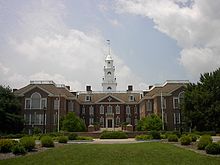Government of Delaware
The Government of Delaware encompasses the administrative structure of the US state of Delaware as established by its 1897 constitution. Analogously to the US federal government, it is composed of three branches: executive, legislative, and judicial. The Governor is head of the executive, the General Assembly is the legislature, and the Supreme Court is the highest court. The state is also organized into counties, municipalities, school districts, and special districts.
Executive branch[]
The executive branch is headed by the Governor of Delaware. The present governor is John Carney (Democrat), who took office January 17, 2017. The lieutenant governor is Bethany Hall-Long. The governor presents a "State of the State" speech to a joint session of the Delaware legislature annually.[1]
Legislative branch[]

The Delaware General Assembly consists of a House of Representatives with 41 members and a Senate with 21 members. It sits in Dover, the state capital. Representatives are elected to two-year terms, while senators are elected to four-year terms. The Senate confirms judicial and other nominees appointed by the governor.
Delaware's U.S. Senators are Tom Carper (Democrat) and Chris Coons (Democrat). Delaware's single U.S. Representative is Lisa Blunt Rochester (Democrat).
Judicial branch[]
The Delaware Constitution establishes a number of courts:
- The Delaware Supreme Court is the state's highest court.
- The Delaware Superior Court is the state's trial court of general jurisdiction.
- The Delaware Court of Chancery deals primarily in corporate disputes.
- The Family Court handles domestic and custody matters.
- The Delaware Court of Common Pleas has jurisdiction over a limited class of civil and criminal matters.
Minor non-constitutional courts include the Justice of the Peace Courts and Aldermen's Courts.
Significantly, Delaware has one of the few remaining Courts of Chancery in the nation, which has jurisdiction over equity cases, the vast majority of which are corporate disputes, many relating to mergers and acquisitions. The Court of Chancery and the Delaware Supreme Court have developed a worldwide reputation for rendering concise opinions concerning corporate law which generally (but not always) grant broad discretion to corporate boards of directors and officers. In addition, the Delaware General Corporation Law, which forms the basis of the Courts' opinions, is widely regarded as giving great flexibility to corporations to manage their affairs. For these reasons, Delaware is considered to have the most business-friendly legal system in the United States; therefore a great number of companies are incorporated in Delaware, including 60% of the companies listed on the New York Stock Exchange.[2]
Delaware was the last U.S. state to use judicial corporal punishment, in 1952.[3]
Counties[]
Delaware is subdivided into three counties; from north to south they are New Castle, Kent and Sussex. This is the fewest among all states. Each county elects its own legislative body (known in New Castle and Sussex counties as County Council, and in Kent County as Levy Court), which deal primarily in zoning and development issues. Most functions which are handled on a county-by-county basis in other states—such as court and law enforcement—have been centralized in Delaware, leading to a significant concentration of power in the Delaware state government. The counties were historically divided into hundreds, which were used as tax reporting and voting districts until the 1960s, but now serve no administrative role, their only current official legal use being in real estate title descriptions.[4]
References[]
- ^ "Delaware House of Representatives Minority Caucus". 2010. Archived from the original on April 16, 2009. Retrieved January 24, 2001.
- ^ "About Agency". Delaware Division of Corporations. Archived from the original on February 28, 2007. Retrieved July 23, 2008.
- ^ Pleck, Elizabeth Hefkin (2004). Domestic tyranny: the making of American social policy against family. University of Illinois Press. p. 120. ISBN 978-0-252-07175-1. Archived from the original on December 31, 2015. Retrieved October 16, 2015.
- ^ "The Hundreds of Delaware". Department of State: Division of Historical and Cultural Affairs. Delaware State Archives. Archived from the original on June 17, 2010. Retrieved September 28, 2010.
Further reading[]
- Boyer, William W.; Ratledge, Edward C. (2009). Delaware Politics and Government. University of Nebraska Press. ISBN 978-0-8032-6220-1.
External links[]
- Government of Delaware
- Delaware law
- State governments of the United States
